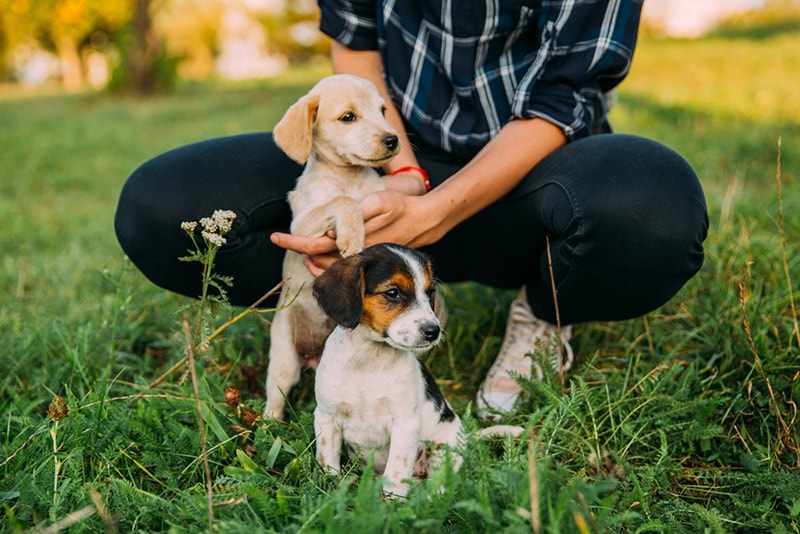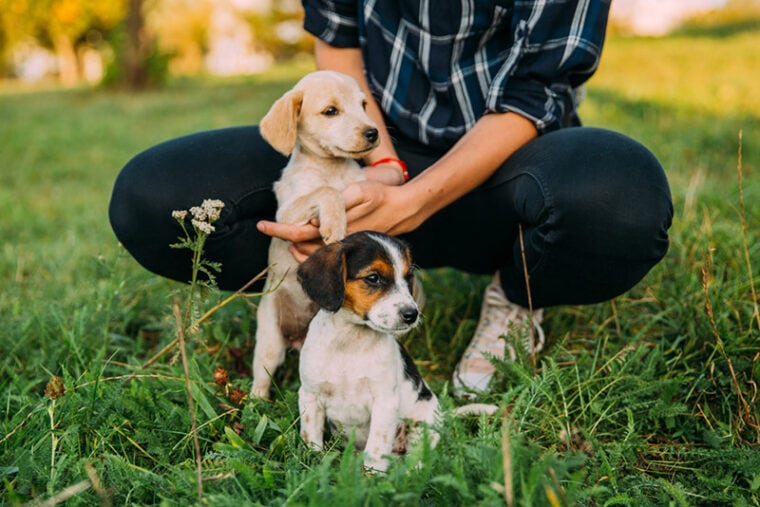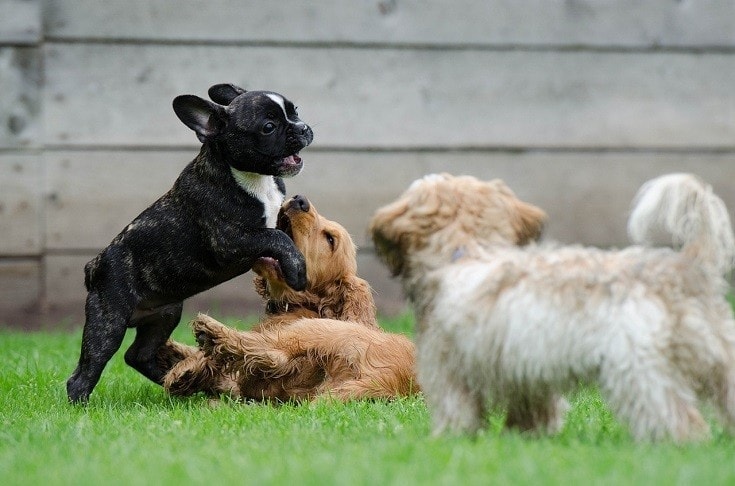- August 4, 2023
Puppy Socialization: Timing & Importance Explained (Step-by-Step Guide)



The information is current and up-to-date in accordance with the latest veterinarian research.
Puppies may have short attention spans, but they’re still terrific information sponges. Indeed, what they learn before they’re even 3 months of age will affect their behavior for the rest of their lives. It is your responsibility to take advantage of this critical socialization window to socialize your pup and help them become a well adjusted member of society.
That said, the whole process of puppy socialization can be a bit daunting for new dog owners, so we put together this handy guide to help you navigate each step.
First, though, let’s answer common questions about when and why puppy socialization is so important.

Why Should You Socialize Your Puppy?
Puppy socialization is a critical process that helps your tiny dog become well-adjusted and confident in various social situations. It involves exposing them positively to a wide range of experiences, people, animals, and environments during their early developmental stages. This way, you can help them develop positive associations and exhibit appropriate behavior.
Early socialization also serves to prevent the appearance of problematic behaviors, such as:
- Anxiety
- Aggression toward people or other animals
- Excessive fear of noises or new situations
Unfortunately, behavioral problems are among the main causes of the abandonment of dogs in animal shelters, hence the importance of not skipping the socialization period.
Why Is Timing So Important During Puppy Socialization?
Timing is crucial when it comes to puppy socialization. It should ideally begin at 3 weeks of age and continue until around 16 weeks. During this time, puppies are highly receptive to new experiences and more adaptable to change.
But that doesn’t mean your puppy training is over afterward! Socializing your little friend is only the first step in their education, which should continue throughout their life.
Important: Wait at least 1 week after your puppy’s first vaccinations before undertaking socialization exercises outside your home. This will limit their chances of getting sick. Check with your veterinarian for guidance on this.


Step-by-Step Puppy Socialization Process
Here are the main steps of successful (and fun!) puppy socialization:
1. Introduce your puppy to various people
Expose your puppy to people of different ages, sizes, ethnicities, and appearances. Encourage gentle interactions and positive experiences with strangers.
2. Socialize with other dogs
Arrange controlled playdates with other well-vaccinated and friendly dogs. That said, always supervise the interactions to ensure that they are positive and not overwhelming for your little one.

3. Expose them to different environments
Gradually introduce your puppy to different environments, such as parks, streets, car rides, and other public places, to help them become comfortable in these settings.
4. Familiarize them to different sounds
Expose your puppy to various sounds, including traffic noises, vacuum cleaners, doorbells, sirens, and children playing. Start with low volume (when possible!), and gradually increase it as they become more comfortable. Many recorded noises are available for this purpose.

5. Encourage positive experiences with various objects
Introduce your puppy to common objects that they will encounter in daily life, such as umbrellas, bicycles, strollers, and household appliances.
6. Do basic obedience training
Teach them basic commands like sit, stay, and come. This is an absolute must to establish expected behavior and will build a strong bond between you and your puppy.

7. Ensure controlled exposure to children and other animals
If possible, gradually introduce your puppy to well-behaved children and other pets in a safe environment. This helps them learn appropriate behavior and promotes positive socialization.

A Few Things to Keep In Mind for a Smooth Puppy Socialization
- Keep calm and don’t overdo it! Every experience should be positive and fun. Make sure they are happy and relaxed before introducing them to a new situation.
- Playtime should ideally be with other well-behaved, healthy, and vaccinated dogs. Avoid unfamiliar animals and parks where dogs are off leash (at least early in the socialization period, especially if your pup seems nervous or scared).
- Provide positive reinforcement, treats, and love every step of the way.
- Be patient, and go at your puppy’s pace, as each dog is unique.
- Socializing includes becoming accustomed to being handled, mouth, ears, feet etc.
- Ask your veterinary clinic for a list of puppy classes offered in your area. These are great opportunities to safely expose your pup to new situations while teaching them good behaviors.

Puppy Socialization Checklist
People
- Babies
- Toddlers
- Children
- Teenagers
- Adults
- The elderly
- Those with different physical features
- Those of different ethnicities
People with:
- Baby carriers
- Backpacks
- Beards
- Canes
- Crutches
- Hats/Hoodies
- Luggage
- Masks
- Sunglasses
- Skateboards
- Strollers
- Wheelchairs
Animals
- Other dogs
- Cats
- Birds
- Small pets (rabbits, hamsters, guinea pigs, etc.)
- Horses
- Farm animals
Vehicles
- Airplanes
- Bicycles
- Buses
- Cars
- Motorbikes
- Scooters
- Trucks
Sounds
- Alarms
- Car horns
- Doorbells
- Fireworks
- Mowers
- Thunderstorms
- Sirens
- Vacuum cleaners
- Washing machine
- Other noisy appliances
Places and/or situations
- Veterinary clinic
- Transport carrier
- Road trip in a car
- House of friends/parents
- Parking
- Railway tracks
- Hiking trails
- Dog park
- Shopping center
- Other public places

Final Thoughts
Puppy socialization is mandatory to ensure that your sweet pup grows into a well-rounded, easy-going adult dog. Investing time and effort in a good education will prepare your new furry friend for a lifetime of positive social interactions and enriching experiences. Keep in mind that you can always seek the help of a qualified dog trainer or canine behaviorist if you run into tricky issues during this process.
Featured Image Credit: Angyalosi Beata, Shutterstock
Tags
What do you think?
Related Articles

New Puppy Checklist: Gear You’ll Need for Your New Dog
Getting a new puppy is really exciting, but before you welcome them home, it’s important to prepare your space for them. Since puppies need a

How Big Do Mini Poodles Get? Vet Reviewed Average Weight & Growth Chart – Dogster
The information is current and up-to-date in accordance with the latest veterinarian research. Learn more » When you buy a Miniature Poodle, you might not

Can Police Dogs Smell Nicotine? Vet Verified Facts & Info – Dogster
The information is current and up-to-date in accordance with the latest veterinarian research. Learn more » While cigarette sales have been declining steadily for decades,

How Old Is 5 in Dog Years? Vet-Approved Guide to Each Size of Dog – Dogster
The information is current and up-to-date in accordance with the latest veterinarian research. Learn more » A common method for calculating a dog’s age is

